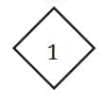Worksheet: A Story of Numbers | Mathematics Class 8- New NCERT (Ganita Prakash) PDF Download
| Table of contents |

|
| 1. MCQs |

|
| 2. True / False |

|
| 3. Fill in the blanks |

|
| 4. Answer the following Questions |

|
1. MCQs
Q1: In the Roman numeral system, what number does MCMXLIV represent?
a) 1944
b) 1444
c) 1949
d) 1494
Q2: If the base of a number system is 7, what is the 4th landmark number after 1?
a) 28
b) 49
c) 343
d) 7
Answer: b) 49
Q3: Symbol is representation for which number?
is representation for which number?
a) 60
b) 360
c) 3600
d) any multiple of 60
Q4: In a base-8 system, what is the value of the number 345 (base 8) in base-10?
a) 229
b) 228
c) 230
d) 231
Q5: In a base-5 system, the third landmark number after 1 is:
a) 15
b) 25
c) 20
d) 30
2. True / False
Q1: The Bakhshali manuscript contains the earliest known example of the number zero written as a dot.
Q2: Roman numerals can easily be used for multiplication and division.
Q3:The Gumulgal people counted numbers in groups of 2.
Q4: The Lebombo bone is believed to be younger than the Ishango bone.
Q5: In the Egyptian number system, each landmark number is 10 times the previous one.
3. Fill in the blanks
Q1: The ancient counting device made of a frame with rods and beads is called an __________.
Q2: In the Roman numeral system, C represents the number __________.
Q3: The Roman numeral for 1000 is represented as __________.
Q4: The Roman numeral for 50 is represented as __________.
Q5: A number system in which each landmark number is obtained by multiplying the previous landmark number by a fixed number n is called a __________ system.
4. Answer the following Questions
Q1. Represent the following numbers in the Roman system.
(i) 1444
(ii) 1867
(iii) 2539
(iv) 948
Q2. Consider the extension of the Gumulgal number system beyond 6 in the same way of counting by 2s. Come up with ways of performing the different arithmetic operations (+, –, ×, ÷) for numbers occurring in this system, without using Hindu numerals. Use this to evaluate the following:
(i) (ukasar-ukasar-ukasar-urapon) + (ukasar-urapon)
(ii) (ukasar-ukasar-ukasar-ukasar-urapon) − (ukasar-ukasar-urapon)
(iii) (ukasar-ukasar-ukasar) × (ukasar-urapon)
(iv) (ukasar-ukasar-ukasar-ukasar-ukasar-ukasar) ÷ (ukasar-ukasar)
Q3: Represent the following numbers in the Egyptian system:
(i) 54321
(ii) 8888
(iii) 26005
Q4: Express the number 87 in this base-5 symbolic system.
Q5: Add : XLVIII + XXXVI
Q6: Write Mesopotamian symbol representation for each number.
(i) 58
(ii) 214
(iii) 305
Q7: Convert the decimal number 150 to its base-7 representation. Show your working and write the answer using digits from 0 to 6.
Q8: Express the number 999 in this new system.
Q9. Add the following numerals that are in the base-5 system that we created:
Remember that in this system, 5 times a landmark number gives the next one!
Q10: How would the Mesopotamians have written 20, 50, 100?
You can access the solutions to this unit test here.
|
26 videos|133 docs|11 tests
|
FAQs on Worksheet: A Story of Numbers - Mathematics Class 8- New NCERT (Ganita Prakash)
| 1. What is the significance of numbers in storytelling? |  |
| 2. How can numbers be used effectively in a narrative? |  |
| 3. What are some common mathematical concepts that relate to storytelling? |  |
| 4. How do historical events incorporate the use of numbers? |  |
| 5. Why is it important for students to learn about the relationship between numbers and stories? |  |















